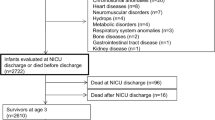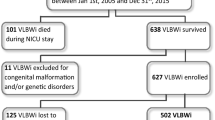Abstract
The preterm very low birth weight infants are at high risk of developing neurodevelopmental delay despite little or no medical complications at the time of birth. The care and interventions of such infants have an impact on the pre-existing risk. The Developmental Care Interventions (DCI) are the range of treatment strategies aiming to alleviate the risk thereby improving neuro-developmental outcomes. The objective of this review is to appraise the range of such interventions for preterm very low birth weight infants reported in the literature. This review will help clinicians to adopt developmental intervention strategy to improve the neuro-developmental outcomes of their NICU graduates.
Similar content being viewed by others
Explore related subjects
Discover the latest articles and news from researchers in related subjects, suggested using machine learning.References
Lickliter R. The integrated development of sensory organization. Clin Perinatol. 2011;38: 591–603.
Spittle AJ, Orton J, Doyle LW, Boyd R. Early developmental intervention programs post hospital discharge to prevent motor and cognitive impairments in preterm infants. Cochrane Database Syst Rev. 2007;2:CD005495.
Symington A, Pinelli J. Developmental care for promoting development and preventing morbidity in preterm infants. Cochrane Database. Syst Rev. 2006;2:CD001814.
Harrison LL. Tactile stimulation of neonatal Intensive Care Unit preterm. In: Field T, editor. Touch and Massage in Early Child Development. Johnson & Johnson Pediatric Institute LLC, USA: 2004;139–162.
van Sleuwen BE, Engelberts AC, Boere-Boonekamp MM, Kuis W, Schulpen TW, L’Hoir MP. Swaddling: a systematic review. Pediatrics. 2007;120:e1097–e1106.
Mohrbacher N. Rethinking swaddling. Int J Childbirth Educ. 2010;25:7–10.
Harrison LL, Williams AK, Berbaum ML, Stem JT, Leeper J. Physiologic and behavioral effects of gentle human touch on preterm infants. Res Nurs Health. 2000;23:435–446.
de Róiste A. TAC-TIC therapy with premature infants: a series of investigative studies. Neuro Endocrinol Lett. 2004;25:67–77.
Field T, Diego M, Hernandez-Reif M. Preterm infant massage therapy research: a review. Infant Behav Dev. 2010;33:115–124.
Vickers A, Ohlsson A, Lacy JB, Horsley A. Massage for promoting growth and development of preterm and/or low birth-weight infants. Cochrane Database Syst Rev. 2004;2:CD000390.
Sankaranarayanan K, Mondkar JA, Chauhan MM, Mascarenhas BM, Mainkar AR, Salvi RY. Oil massage in neonates: an open randomized controlled study of coconut versus mineral oil. Indian Pediatr. 2005;42:877–884.
Graven S. Sleep and brain development. Clin Perinatol. 2006;33:693–706.
Pillai Riddell RR, Racine NM, Turcotte K, Um an LS, Horton RE, Din Osmun L, et al. Non-pharmacological management of infant and young child procedural pain. Cochrane Database Syst Rev. 2011;10:CD006275.
Bellieni CV, Buonocore G, Nenci A, Franci N, Cordelli DM, Bagnoli F. Sensorial saturation: an effective analgesic tool for heel-prick in preterm infants: a prospective randomized trial. Biol Neonate. 2001;80:15–18.
Moyer-Mileur LJ, Brunstetter V, McNaught TP, Gill G, Chan GM. Daily physical activity program increases bone mineralization and growth in preterm very low birth weight infants. Pediatrics. 2000;106:1088–1092.
Eliakim A, Dolfin T, Weiss E, Shainkin-Kestenbaum R, Lis M, Nemet D. The effects of exercise on body weight and circulating leptin in premature infants. J Perinatol. 2002;22: 550–554.
Schulzke SM, Trachsel D, Patole SK. Physical activity programs for promoting bone mineralization and growth in preterm infants. Cochrane Database Syst Rev. 2007;2:CD005387.
Laughlin J, Luerssen TG, Dias MS, Committee on Practice and Ambulatory Medicine, Section on Neurological Surgery. Prevention and Management of Positional Skull Deformities in Infants. Pediatrics. 2011;128:1236–1241.
Collett B, Breiger D, King D, Cunningham M, Speltz M. Neurodevelopmental implications of “deformational” plagiocephaly. J Dev Behav Pediatr. 2005;26:379–389.
Pin T, Eldridge B, Galea MP. A review of the effects of sleep position, play position, and equipment use on motor development in infants. Dev Med Child Neurol. 2007;49:858–867.
Nakano H, Kihara H, Nakano J, Konishi Y. The influence of positioning of spontaneous movements of preterm infants. J Phys Ther Sci. 2010;22:337–344.
Lipchock SV, Reed DR, Mennella JA. The gustatory and olfactory systems during infancy: implications for development of feeding behaviors in the high-risk neonate. Clin Perinatol. 2011;38:627–641.
Yildiz A, Arikan D. The effects of giving pacifiers to premature infants and making them listen to lullabies on their transition period for total oral feeding and sucking success. J Clin Nurs. 2012;21:644–656.
Pinelli J, Symington A. Non-nutritive sucking for promoting physiologic stability and nutrition in preterm infants. Cochrane Database Syst Rev. 2005;4:CD001071.
Lessen BS. Effect of the premature infant oral motor intervention on feeding progression and length of stay in preterm infants. Adv Neonatal Care. 2011;11:129–139.
Anderson JW, Johnstone BM, Remley DT. Breast-feeding and cognitive development: a meta-analysis. Am J Clin Nutr. 1999;70:525–535.
Kramer MS, Kakuma R. Optimal duration of exclusive breastfeeding. Cochrane Database Syst Rev. 2012;8:CD003517.
Rozé JC, Darmaun D, Boquien CY, Flamant C, Picaud JC, Savagner C, et al. The apparent breastfeeding paradox in very preterm infants: relationship between breast feeding, early weight gain and neurodevelopment based on results from two cohorts, EPIPAGE and LIFT. BMJ Open. 2012;2:e000834.
Ottenbacher K. Developmental implications of clinically applied vestibular stimulation. Phys Ther. 1983;63:338–342.
Moon C. The role of early auditory development in attachment and communication. Clin Perinatol. 2011;38:657–669.
Darcy AE, Hancock LE, Ware EJ. A descriptive study of noise in the neonatal intensive care unit: ambient levels and perceptions of contributing factors. Adv Neonatal Care. 2008;8: S16–S26.
Graven SN. Sound and the developing infant in the NICU: conclusions and recommendations for care. J Perinatol. 2000;20:S88–S93.
Ramesh A, Denzil SB, Linda R, Josephine PK, Nagapoornima M, Rao PS, et al. Maintaining Reduced Noise Levels in a Resource Constrained Neonatal Intensive Care Unit by Operant Conditioning. Indian Pediatr. 2012. [Epub ahead of print].
Graven SN. Early visual development: implications for the neonatal intensive care unit and care. Clin Perinatol. 2011;38:671–683.
Rivkees SA, Mayes L, Jacobs H, Gross I. Rest-activity patterns of premature infants are regulated by cycled lighting. Pediatrics. 2004;113:833–839.
Morag I, Ohlsson A. Cycled light in the intensive care unit for preterm and low birth weight infants. Cochrane Database Syst Rev. 2011;1:CD006982.
Susan M. Ludington-Hoe, Kathy Morgan, Amel Abouelfettoh. A Clinical Guideline for Implementation of Kangaroo Care with Premature Infants of 30 or More Weeks’ Postmenstrual Age. Adv in Neonatal Care. 2008;8:S3–S23.
Conde-Agudelo A, Belizán JM, Diaz-Rossello J. Kangaroo mother care to reduce morbidity and mortality in low birthweight infants. Cochrane Database Syst Rev. 2011;3:CD002771.
White-Traut R. Providing a nurturing environment for infants in adverse situations: multisensory strategies for newborn care. J Midwifery Womens Health. 2004;49:36–41.
White-Traut RC, Nelson MN, Silvestri JM, Vasan U, Littau S, Meleedy-Rey P, Gu G, et al. Effect of auditory, tactile, visual, and vestibular intervention on length of stay, alertness, and feeding progression in preterm infants. Dev Med Child Neurol. 2002;44:91–97.
Nair MK, Philip E, Jeyaseelan L, George B, Mathews S, Padma K. Effect of Child Development Centre model early stimulation among at risk babies-a randomized controlled trial. Indian Pediatr. 2009;46:s20–s26.
Author information
Authors and Affiliations
Corresponding author
Rights and permissions
About this article
Cite this article
Ramachandran, S., Dutta, S. Early developmental care interventions of preterm very low birth weight infants. Indian Pediatr 50, 765–770 (2013). https://doi.org/10.1007/s13312-013-0221-y
Published:
Issue Date:
DOI: https://doi.org/10.1007/s13312-013-0221-y




